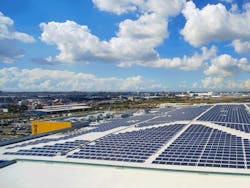of One Step Off The Grid provides an update on a microgrid being built by Ikea in Adelaide, the capital city of South Australia.
The groundbreaking solar and battery microgrid being built to power the Adelaide store of Swedish furniture giant, Ikea, has reached a major milestone, after the rooftop PV component of the project was energized during commissioning last week.
The milestone was announced on LinkedIn on Monday by Planet Ark Power, the Brisbane-based company that is developing the microgrid in conjunction with Ikea, SA Power Networks, Epic Energy and Schneider Electric.
The $6.6 million project, flagged by Ikea Australia in mid-2020, will combine 1.2 MW of solar on the rooftop of the Adelaide Ikea megastore with a 3MW/3.3MWh OilPower CATL lithium-ion battery storage system.
The microgrid, which will be owned and operated by Epic Energy, will also use Planet Ark Power’s eleXsys energy management system, a dynamic solar management solution that works to optimize export revenues and grid integration.
Planet Ark Power said on Monday that, with the electrical infrastructure complete and the civil works well underway, the battery and eleXsys controllers, housed in 4 x 40 ft. containers, were scheduled to be installed in April.
“The microgrid represents a significant step forward for Ikea in meeting its goal to be carbon neutral by 2030,” the LinkedIn post said.
“With the powerful solar PV system comprising solar panels from Q Cells Australia and inverters from SMA Australia, [the microgrid] will be used to power up to 70% of the electricity needs at the 23,500 sqm facility.”
EleXsys Energy, which trades in Australia as Planet Ark Power, last May completed a $A6.55 million capital raise, with funds coming mostly from investors in Australia and the UK, where eleXsys has been in the process of being incorporated.
Just this week, the company announced it would trial its voltage control technology across five locations in the Queensland grid, with three devices installed within the Energy Queensland network, an additional device installed at a behind-the-meter premises, and another to be used for testing at a real-time simulator facility operated by Energy Queensland in Cairns.
EleXsys COO and CFO, Jonathan Ruddick, said last year that the inclusion of the company’s energy management system in the Ikea microgrid was the critical link that made the project “so innovative and world leading.”
“Our eleXsys technology solution functions to ensure certainty of revenue streams from the export of surplus solar energy and grid stability services into the grid without the risk of curtailment by electricity network operators,” he said.
“What we’re doing is bringing those large remote solar and wind farms into the urban environment where the energy is actually needed, avoiding transmission costs and giving confidence that voltage management is being provided dynamically.”
“Once you solve those zero export issues, the investment becomes de-risked … and that’s where Epic Energy comes into the fold, and enters a PPA [power purchase agreement] with Ikea based on de-risked or predictable investment returns.”
“This results in a new investment class which we call Microgrids as a Service (MAS). These can be used by industrial zones to install optimized rooftop solar and offer the sort of predictable returns on investment that are currently bedeviling the big solar farms.”
This article was originally published by One Step Off The Grid and was reposted with permission. Its author,







